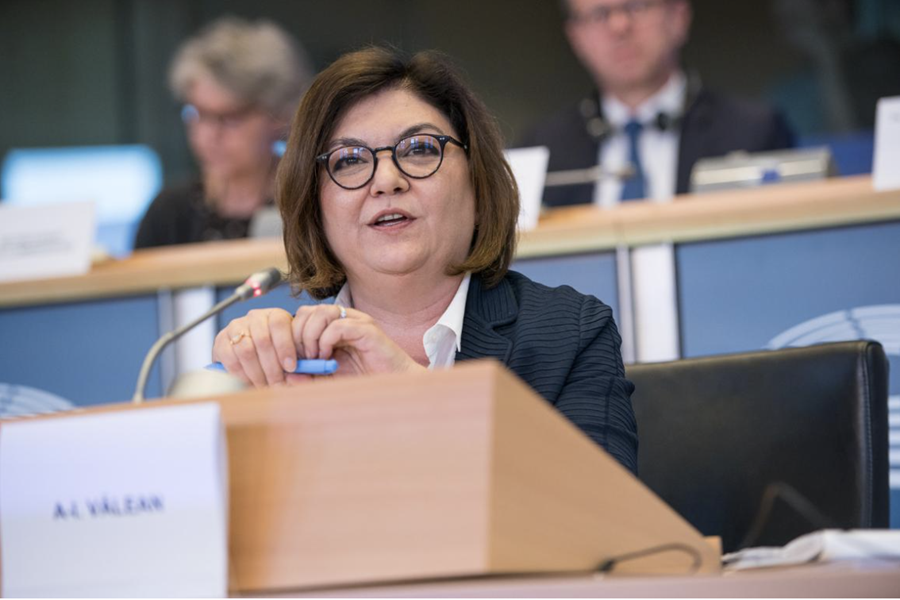
A very warm welcome to the last TISPOL Bulletin of 2019...

We hope you have enjoyed our fortnightly selections of road safety and road policing news.
Here is our latest round-up:
Here is our latest round-up:
Our warm greetings to the new
European Transport Commissioner
European Transport Commissioner
Adina-Ioana Vălean commits to halve road deaths
and serious injuries by 2030
and serious injuries by 2030

We
are delighted to send our very best wishes to Adina-Ioana Vălean, who
has taken over from Violeta Bulc as European Commissioner for Transport.
Mrs
Vălean was approved for the role at a European Parliament hearing on 14
November. In her opening statement to MEPs she said: “25 000
[road deaths] per year is simply unacceptable. We should share the
objective of halving the number of road deaths and serious injuries by
2030 compared to 2020.”
Later
at the same hearing, in answer to a question from a
member of the Parliament’s transport committee, she affirmed: “For road
safety we are committed to zero vision, zero deaths in 2050. We put a
strategy in place and I plan to promote it strongly. With strategy
come actions.”
The
new Commissioner joined the team headed by new President Ursula von der
Leyen on 1 December. The make-up of the new Commission was approved by
EU Member States on 25 November and by the European Parliament two days
later in a Strasbourg vote.
We
very much look forward to working closely with Mrs Vălean and her team.
We will of course do everything we can to assist in achieving these
targets.
New directive means good
news for cyclists
news for cyclists
New RISM directive will save more than 3,000 cyclists’ lives
After
two years of active lobbying by the European Cyclists’ Federation, the
revised Directive on Road Infrastructure Safety Management (RISM) has
been published in the Official Journal of the European Union,
representing a ‘major breakthrough’ for cyclists. Up until 2019, the
Directive has almost exclusively focused on the safety of car occupants,
overlooking the needs of other road users such as cyclists and
pedestrians.
Now,
amendments to the Directive include improved planning, design and road
management throughout the EU, taking into account all stages of road
development and paying more attention to cyclists and
pedestrians.
According
to research from the European Commission, the proposed measures could
save as many as 3,200 lives and prevent more than 20,000 serious
injuries between 2020-30.
Italy: Prince Michael Award for National Road Police Force

The Polizia
Stradale (National Road Police Force) has won a 2019 prestigious Prince
Michael International Road Safety Award for “Safe School
Trips” programme.
HRH
the Prince Michael of Kent (pictured above with award) delivered the
prize to the Polizia Stradale Deputy Director Santo Puccia during the
annual ceremony held at the Savoy Hotel in London Tuesday 10 December
2019. Member of the Italian Delegation were also TISPOL President of
Honour Paolo Cestra and the member of TISPOL Operations Group Alessandro
Lo Dico.
According
to the notification received, the panel of judges thought “Safe School
Trips” programme aims to make school transport as safe as possible.
Big rise in Denmark’s road deaths
159
traffic deaths were recorded in Denmark in the first ten months of
2019. The figure for the corresponding period in 2018 was 134
fatalities, meaning the country has a worse record for fatal accidents
this year than last.
The
government has announced a Road Safety Commission to improve road
safety in Denmark in response to the concerning statistic, the Ministry
of Transport and Housing has said in a press statement.
“It
is tragic that the number of traffic fatalities is increasing and that
95 per cent of road accidents occur due
to human behaviour,” transport minister Benny Engelbrecht said in the
statement. “This is simply a sign that we are not taking enough care of
ourselves and each other on the roads,” the minister added.
Finland: new law will allow robots to monitor driver phone and seatbelt use
The
number of officers on patrol in Finland has been falling for a decade,
while police and the National Audit Office (VTV) say that Finnish roads
have never been safer.
The
number of hours spent by humans on traffic monitoring fell by 17
percent in 2012-2018. Officers now typically respond to emergency calls
while robotic sensors take care of the day-to-day road safety business,
said Maria Hoikkala from the National Police Board.
A new traffic law will come into effect in June 2020, leading to the wider use of technologies
and devices such as drones in traffic monitoring.
"Automatic systems will be able to monitor things like mobile phone and seat belt use for the first time," Hoikkala said.
Latvia: hopes for reduced road
death toll in 2020
death toll in 2020
A
total of 107 people have died in road accidents so far this year, and
the traffic safety situation has not improved much, officials at the
Road Traffic Safety Council officials said November 25, according to the
LETA news agency.
According
to Normunds Krapsis, head of the State Police's Traffic Safety
Department, 107 people have died in traffic accidents so far this year,
compared to 120 road fatalities in January-October last year and 108
road fatalities in the same period in 2017. However, winter in Latvia
has only just begun and December is still ahead, he added.
Assessing overall traffic safety, Krapsis said: "The situation is satisfactory, but there is no reason to rejoice".
In
total, 48 motorists, 31 pedestrians and 14 passengers have been killed
in road accidents so far this year. The number also includes five
children, and the police point out that children in automobiles often do
not fasten their seatbelts.
Czech pedestrian casualties rise
A
total of 113 pedestrians died during Czech road accidents last year,
and 101 the year before, the Vision O group, associating organisations
dealing with road traffic safety, told journalists today. The
pedestrians face a danger especially at night, when most road
collisions occur. The biggest danger threatens pedestrians during the
winter months when there is darkness more often.
Between
2006 and 2016, 54 percent of the annual number of fatalities occurred
between November and March. Outside municipalities, pedestrians must
use reflective elements on their clothes under the law. If they fail to
do so, they may be
fined or face problems with insurance companies.
UK: official figures show
drink-drive increase
drink-drive increase
Fatal
and serious drink-drive casualties have reached their highest level
since 2010, according to new figures from there Department for
Transport.
The
sharp rise in drink-drive casualties coincides with a 17% drop in
police numbers over the same time period, and a 55% reduction in the
number of roadside breath tests.
The
latest DfT figures show in 2017 there were 250 road users killed in
drink-drive accidents, the highest number on record since 2010. Across
the same time period, the number of serious drink-drive accidents rose
from 1,240
to 1,380.
In
2010, police conducted 737,000 roadside tests, with 11% recorded as
positive for alcohol. In 2017, just 326,000 roadside breath tests took
place, with 16% of all drivers recording a positive sample.
The
lead up to Christmas will be a particularly busy time for police across
the country; the latest figures show the month of December sees up to a
20% spike in drink-drive accidents.
GEM
road safety office Neil Worth said: “Please do not think that just
because you’re less likely to be stopped and breathalysed by the police
that’s its acceptable to drive after drinking alcohol.
“It
absolutely is not, and the figures show that more people are dying as a
result of someone’s choice to drink drive than at any time in the past
decade.”
The current drink-drive limit in England and Wales is 80mg/100ml, with Scotland having adopted a lower 50mg/100ml limit in 2014.



Δεν υπάρχουν σχόλια:
Δημοσίευση σχολίου